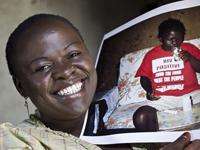Latest UNAIDS treatment numbers show progress, but funding crunch is a major threat
Without appropriate funding, the opportunity to reap the benefits of new science showing that HIV treatment both saves lives and helps prevent new infections could be lost.
Geneva/New York, November 21, 2011 – The growing number of HIV/AIDS deaths averted, according to data released today by UNAIDS, represents important progress, but the number of people put on treatment must increase dramatically in order to reap the benefits of new science showing that HIV treatment both saves lives and helps prevent new infections, the international medical humanitarian organization Médecins Sans Frontières/Doctors Without Borders (MSF) said today. This will require significant additional funding for HIV treatment, yet, as the Global Fund to Fight AIDS, TB and Malaria’s board meeting opens today in Accra, Ghana, AIDS funding has now declined for two years in a row.
In 2011, landmark research showed that a person starting HIV treatment early is 96 percent less likely to pass the virus on to others. This year also brought increased political commitment. The US has just announced its goal of “turning the tide on AIDS,” a declaration once unimaginable, as official US policy. Governments in June committed to reaching 15 million people with HIV treatment by 2015 with the Global Fund to Fight AIDS, TB and Malaria poised to agree to help pay for half of that target.
With treatment scale-up now under increasing threat, MSF calls on donor and affected governments alike to ensure this plan to roll out benefits from treatment acceleration becomes a reality. But the funding needed to turn this year’s scientific and political breakthroughs into increased access to treatment for millions of people, is severely lacking, with the Global Fund now forced to skip a year of funding new proposals for the first time since it was created in 2002.
“Never, in more than a decade of treating people living with HIV/AIDS, have we been at such a promising moment to really turn this epidemic around,” said Dr. Tido von Schoen-Angerer, executive director of MSF’s Access Campaign. “Governments in some of the hardest hit countries want to act on the science, seize this moment and reverse the AIDS epidemic. But this means nothing if there’s no money to make it happen.”
In several countries where MSF works—such as Malawi, Zambia, Kenya and South Africa—governments are seeking to implement ambitious national HIV treatment plans by incorporating "accelerated treatment" components such as initiation of treatment for people at an earlier stage of the disease, immediate initiation of treatment for HIV-positive people with HIV-negative partners, and immediate initiation of life-long treatment for HIV-positive expectant mothers.
But without increased funding, opportunities to prevent the spread of infection are being missed and there is a real risk of going backwards. The Global Fund's budget shortfall this year and next means ambitious country proposals to save more lives and greatly reduce new infections cannot be funded. MSF witnesses how even existing national treatment programs are now under threat of being severely curtailed in countries such as Zimbabwe, Mozambique and the Democratic Republic of Congo.
MSF calls on the Global Fund not to further delay, downsize, or cap its newest round of funding applications. Donors and the Fund should raise the funding necessary to cover the costs of quality proposals in order to enable countries to realize priority interventions that will have the highest impact on the epidemic.
“Right now, we’re in an absurd situation where the signposts all point in one direction to get a handle on HIV/AIDS, yet the funding crunch is pulling us the opposite way,” said Shelagh Woods, head of MSF's project in rural Malawi. “We have to act fast and reach as many people as possible to save lives and avoid slipping back, but countries can't do this alone.”
MSF began treating HIV/AIDS in 2000 and currently provides HIV treatment to 170,000 people in 19 countries. In line with the new evidence, MSF has just opened a pilot project in South Africa’s KwaZulu Natal province, which has the country’s highest infection rate, with an aim to reduce infections among the whole community through testing and accelerated treatment, along with conventional prevention.
To learn more, read MSF’s June 2011 report, Getting Ahead of the Wave of New Infections – Lessons for the Next Decade of the AIDS response, or visit www.msfaccess.org




